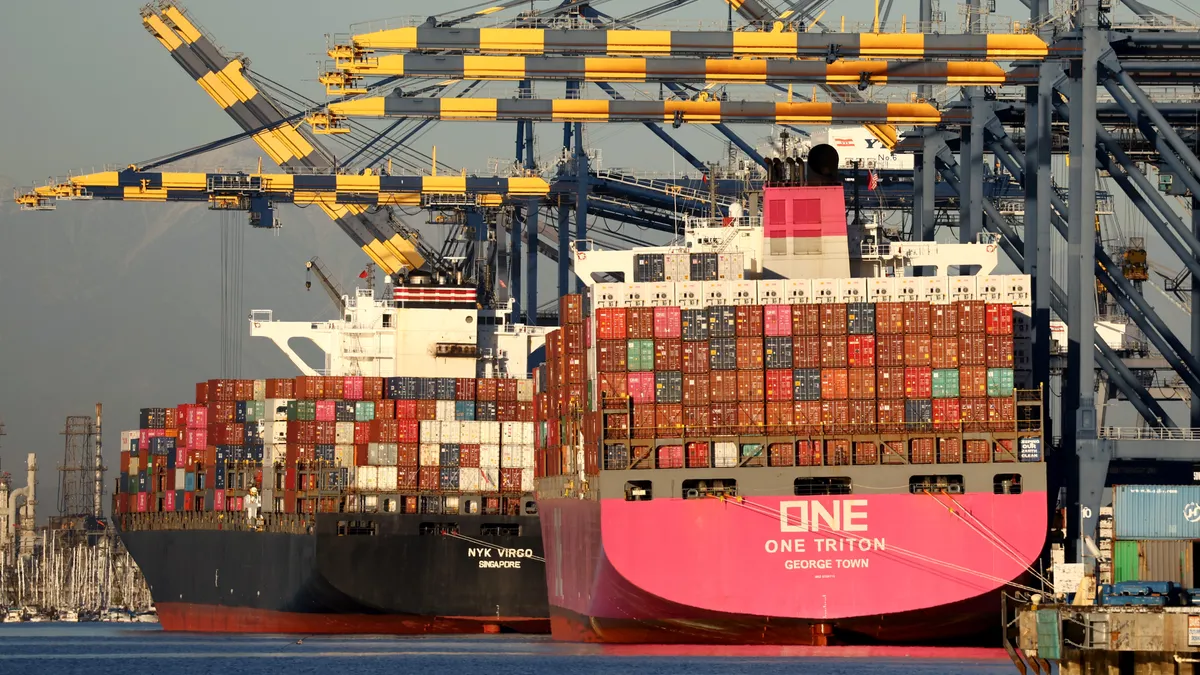Dive Brief:
- May spot prices for ocean shipments from Asia to North America are approaching $5,000 per 40-foot equivalent unit, Freightos reported this week, as Red Sea conflicts and labor uncertainty at East Coast ports affect market dynamics.
- Ocean rates from Asia to the U.S. West Coast rose 13% week over week to $4,917 per FEU, as of May 28, surging 70% from April’s lowest rate of $2,911 per FEU.
- Even higher, shipping prices from Asia to the U.S. East Coast grew 18% week over week to $6,323 per FEU. However, the rates remain lower then February’s high levels, which reached $6,709 per FEU.
Dive Insight:
Shippers may face months of elevated rates and increased delays ahead of peak season if higher demand and restricted capacity continues, Freightos said.
As of Wednesday, China to U.S. West Coast rates are higher than they were in the beginning of the year at $4,312 per FEU, Eytan Buchman, chief marketing officer at Freightos, said in a LinkedIn post. Spot rates in January averaged about $2,713 per FEU.
Shippers are moving some cargo to the West Coast ahead of looming labor negotiations at East and Gulf Coast ports. Meanwhile, Red Sea still poses ongoing logistics risks leading to diverted cargo around the Cape of Good Hope and adding transit days.
Port congestion in Asia could further pressure rates. “Berthing delays of up to a week are currently being experienced at the Southeast Asian port,” with Shanghai and Qingdao ports also witnessing a huge build-up of container ships, according to Westbound Logistics Services.
Earlier this year, a rise in imports from China fueled gains from the Port of Los Angeles and Long Beach.
Meanwhile, with heightened consumer spending, demand is not expected to slow down any time soon, as cargo volumes at the U.S.’ top 12 ports are forecasted to reach over 2 million TEUs through October 2024.
Shipping costs in major trade lanes
“This is essentially pandemic-level disruptions we are now seeing in the market as it comes to the sustained pace of increases over 3 weeks. It is only during the pandemic we have seen similar extreme increases over a 3-week period,” Lars Jensen, CEO and partner at Vespucci Maritime, said in a LinkedIn post.
During the pandemic, congestion at ports along with empty equipment shortages in Asia prompted rates to surge from China and East Asia to both East and West Coast service lanes. Ocean rates continued to rise throughout 2020 as conditions worsened.
On the other hand, Freightos said that the scale of disruptions and price spikes could be less severe than those impacts seen during the pandemic, as volumes are increasing — not surging this time around. Newly developed strategies may also help ports navigate congestion and other challenges, including off-port container yards.
“What many hoped would be an easy and shipper-controlled year has sharply turned once again to a year of uncertainty and disruption,” Stephanie Loomis, head of ocean freight of the Americas for Rhenus Logistics, said in a LinkedIn post.













